Unused content in Phoenix Wright: Ace Attorney — Trials and Tribulations

In this series of articles I will try to list and describe all unused and cut content from GBA, NDS, 3DS and SW/PS4/XOne versions of the first Phoenix Wright Ace Attorney trilogy.
Here we will look into Phoenix Wright: Ace Attorney — Trials and Tribulations. Things you will see below were discovered by me when I was fan-translating the third game.
Generally, most unused content mentioned here could be found in GBA, NDS and 3DS versions. There are exceptions thought, for instance, the GBA version does not feature unused English dialogs since it was released in Japan only.
This article contains spoilers.
2021.08.11 update: added the Unused Animations, Early Sprite Design, Earlier Case 1 Intro Music, GBA Debug Menu and Japanese GBA Demo Version sections, added three new entries to the Unused Sprites section (Young Mia, Godot (2) and Dahlia's Soul) and reworked the Godot (1) entry.2022.04.12 update: added one new entry to the Unused Graphics (DS) section (Beheaded Judge).
2022.07.11 update: updated Folding Screen and Dummy Icon descriptions.
Unused Dialogs: Case 5, Part 1-1: Investigation
Dialog #1
Place: Training Hall Room
Time: When examining the hibachi stove.
| Unused English Dialog | Unused Japanese Dialog |
|
Maya:
Phoenix:
Maya:
Phoenix:
Maya: |
Mayoi:
Naruhodo:
Mayoi:
Naruhodo:
Mayoi: |
Commentary: See below.
Unused Dialogs: Case 5, Part 3-1: Investigation
Dialog #1
Place: Training Hall Room
Time: When examining the hibachi stove.
| Unused English Dialog | Unused Japanese Dialog |
|
von Karma:
Phoenix:
von Karma:
Light it for me, Phoenix
Phoenix: Ouch!
von Karma:
Phoenix |
Karuma:
Naruhodo:
Karuma:
ちょっと、火をつけてみて。
Naruhodo: いてててッ!
Karuma:
Naruhodo: |
Commentary: According to those leftover dialogs, the Training Hall room...
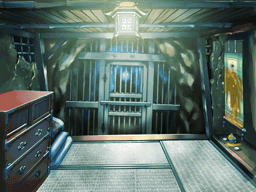
...once had a hibachi stove with two unused dialogs assigned to it.
The fact that those unused dialogs made it to the final game suggest that the stove was removed from this background quite late in the game development.
Placeholder Captions/Icons
In the Japanese version of Ace Attorney for Nintendo DS/3DS each item in the Court Record is comprised of two icons and two separate boxes (images) that contain caption/age and description data respectively.


In the English version icons and captions are stored in the same way, but due to the fact that English text requires more space, descriptions got completely new boxes, while the original description boxes where repurposed to contain the age data and additional info not found in the Japanese version.



Items that only appear on the upper screen have the smaller versions of their icons too (smaller icons are only used to represent evidence in the Court Record), but they were never meant to be used actually: the developers just batch converted all big icons into the smaller ones and never bothered to remove them afterwards.
Strictly speaking, Ace Attorney — Trials and Tribulations does not contain any unused evidence, but it does contain captions for certain items that are only displayed on the upper screen for illustration purposes. Most likely they were never meant to appear in the Court Record as actual evidence since their age and description boxes are empty in both English and Japanese versions — moreover in the GBA version their description boxes have the word "Dummy" in them.
Case 1 — Clock Face
Caption (ENG/JAP), Small Icon (not used):

Commentary: The watch from the victim's photo.
Case 2 — Misty Fey
Caption (ENG/JAP), Small Icon (not used):

Commentary: Its caption can only be found in the DS version.
Case 2 — Cell Phone
Caption (ENG/JAP), Small Icon (not used):

Commentary: Its caption can only be found in the DS version.
Case 2 — Tear of Emanon
Caption (ENG/JAP), Small Icon (not used):

Commentary: Its caption can only be found in the DS version.
Case 2 — Atmey's Bag
Caption (ENG/JAP), Small Icon (not used):

Commentary: Its caption can only be found in the DS version.
Case 2 — Atmey's Jemstone
Caption (ENG/JAP), Small Icon (not used):

Commentary: Its caption can only be found in the DS version.
Case 2 — Unbent Shichishito
Caption (ENG/JAP), Small Icon (not used):

Case 3 — Vase
Caption (ENG/JAP), Small Icon (not used):

Case 3 — Programmer
Caption (ENG/JAP), Small Icon (not used):

Case 3 — Aromatherapy Bottle
Caption (ENG/JAP), Small Icon (not used):

Case 5 — Bloody Letters
Caption (ENG/JAP), Small Icon (not used):

Commentary: Its caption can only be found in the DS version.
Case 5 — Trick Lock
Caption (ENG/JAP), Small Icon (not used):

Commentary: Its caption can only be found in the DS version.
Case 5 — Metal Detector
Caption (ENG/JAP), Small Icon (not used):

Commentary: Its caption can only be found in the DS version.
Case 5 — Opened Talisman
Caption (JAP), Small Icon (not used):
Commentary: Its caption can only be found in the DS version.
Case 5 — Old Photo
Caption (JAP), Small Icon (not used):
Commentary: The small icon of this item looks the same as the big one.
Case 5 — Iris in Hood
Caption (JAP), Small Icon (not used):
Commentary: Its caption can only be found in the DS version.
Manfred von Karma
Caption (ENG/JAP), Small Icon (not used):

Commentary: Its caption can only be found in the DS version.
Folding Screen Icon
Commentary: The Folding Screen icon from the second game. Could only be found in the GBA version. Jusdging from its position among other icons, it was probably meant to be displayed when examinine the folding screen at Kurain exhibit in Case 2.
Kudos to Tox for the tip.
Dummy Icon
Commentary: It seems at one point the game would feature an image/evidence of Glen's Loan Contract, similar to Jean's Loan Contract evidence that appears in the game.
Kudos to Tox for providing the Japanese text.
Dummy Agebox


Commentary: Dummy agebox from unused evidence items.
Unused Questions
Questions appear on the bottom screen when you talk to characters during investigations.


This is the only unused question, which is probably a leftover from the first game, since the third one has no three-day trials.
Unused Choices
Choices mostly appear on the bottom screen during court proceedings and affect the course of actions.
Starting from image #154 ("I have no idea") and until the last image, there are 53 unused choices graphics from Case 3 and 4 of the second game. They go in the same order and contain the same text, so there is no reason to post them here.
This fact also shows that the third game was ported over the second one (which in turn was ported over the first one).
Unused Graphics (DS)
Unlock all Episodes Promt
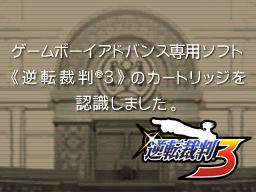
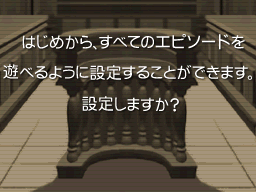
The Japanese version allows to unlock all cases if the GBA version of Gyakuten Saiban 3 is present in the GBA cartridge slot. Since the DS version is the first release of the game outside Japan, this feature was removed but the corresponding images were not.
Unused Background Thumbnails
Background thumbnails are used on the lower screen when you highlight or choose a location entry.
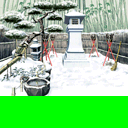

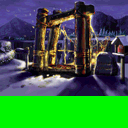
Since the player never visits those locations in the depicted state, those thumbnails go unused.
Early Heavenly Hall Sign Graphics
The Heavenly Hall background thumbnail reveals an interesting detail upon closer inspection, indicating that it had a different sign graphics in the English version at one point:
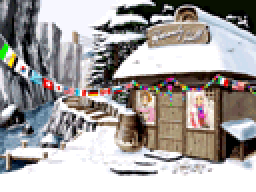
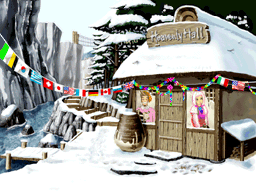
The "Heavenly Hall" text on the thumbnail looks unlike the one found on the full-sized background: "Heavenly" has a slight upward curve to it, and the whole title is apparently based on a handwritten-style font with italics.
Beheaded Judge
The French/German version of the game contains a rather curious background that shows the Judge without... a head. Obviously, it goes unused, since there is a regular clean version of this background in the ROM.
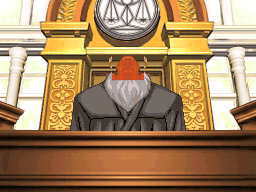
The lower part of the Judge's sprite is reused in all his animation frames, which explains why he lacks his head. Why it appears only in French/German version is beyound anyone's guess.
Kudos to Tox for discovering this image.
Unused Graphics (3DS)
Localized Hazakura Temple Sign
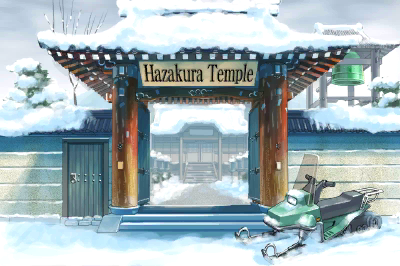
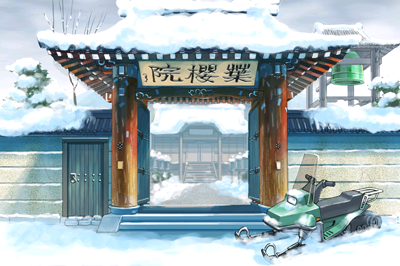
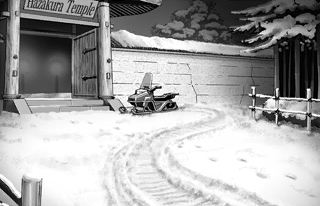
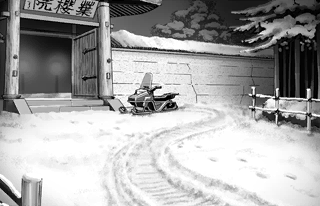
The 3DS re-release contains two unused images that have Hazakura Temple sign in English instead, which is quite surprising, since according to the series localization director Janet Hsu, everything that has to do with the Kurain tradition is left unchanged in the English version. I guess the background artist simply forgot those images should stay as is.
Unused Animations
Tiger
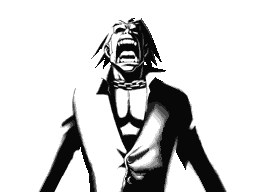
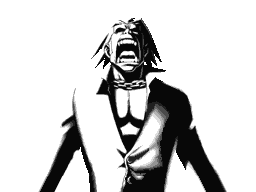
In the original GBA release the Tigre's breakdown animation consisted of four unique frames, but starting from the DS version it was reduced to just two unique frames.
Most likely it was done to reduce the excessive flickering that could provoke epileptic seizure.
Unused Sprites
Young Mia
This unused frame, which could be found in every version of the game, looks pretty similar to the regular sprite, except Mia's sleeves are billowed out due to hand motion. It was meant to appear when Mia hit the desk during her slam animation.
The fact that it appears in the game data suggest it was a last minute change.
Kudos to Tox for finding this unused sprite.
Godot (1)
It seems at one point Godot's slam desk animation contained a unique pose that had four variations seen above. Most likely it was used as a mid frame in the aforementioned animation. It was probably removed to make his strike more powerful.
This sprite could be found inside the Gyakuten Saiban Jiten ROM and in the Art of Gyakuten Saiban book.
Kudos to Tox for finding the Jiten version.
Godot (2)
The Gyakuten Saiban Jiten ROM contains an unused sprite that was probably meant to be used in Godot's mask explosion animation.
Kudos to Tox for finding it.
Dahlia's Soul
An unused sprite of Dahlia's evil soul could be found among other in-game sprites. It looks unlike other poses used during her exorcism animation. However, what is more interesting is that the exorcism animation is implemented using background layers rather then sprites. It suggest that at one point this animation may have looked and functioned unlike the final one.
Kudos to Tox for finding it.
Dahlia Hawthorn
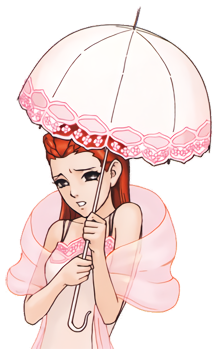
This unused sprite is pretty similar to the one featured in the retail game — which is probably the reason it went unused.
It could only be found in the Art of Gyakuten Saiban book.
Desire DeLight
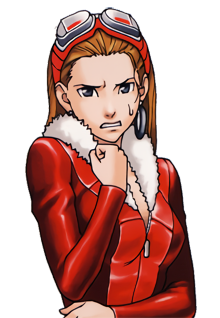
Most probably, it was dropped in favor of similar sprite that appears in the final game.
It could only be found in the Art of Gyakuten Saiban book.
Lisa Basil

In the retail version Lisa Basil's facial expressions are pretty limited — she is either neutral, smiling or nervous. However this unused sprite depicts her in a deeply shocked state.
It could only be found in the Art of Gyakuten Saiban book.
Terry Fawles
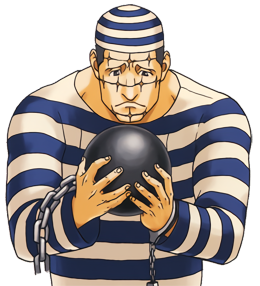
As with some previous sprites, this one too was omitted due to its similarity to another sprite that made it into the game.
It could only be found in the Art of Gyakuten Saiban book.
Early Sprite Design
Young Mia
In the Japanese GBA demo version Mia's finger pointing sprite looks different to the one that appeared in the final game: in the demo version her finger is straight and points above, while in the retail version it is bend and points down. Another noteworthy detail is that the upper part of her lapel is missing in the demo version sprite.
Unused Music
Earlier Case 1 Intro Music
The Japanese GBA demo version features a somewhat different tune and sound effects during the first case's introduction animation.
Leftover Music
Because the third game was ported directly over the second one, which in turn was ported over the first one, it contains several leftover tunes from Phoenix Wright Ace Attorney:
- Pursuit ~ Cornered 2001 (do not confuse with Reminiscence ~ Cornered 2004 that plays in the final)
- Pursuit ~ Cornered (Variation) 2001 (same here)
- Reminiscence ~ Case DL-6
GBA Debug Menu
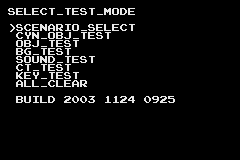
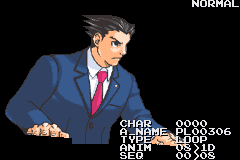
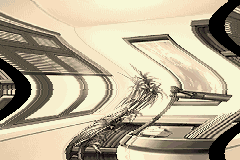
The GBA version of the game features a debug menu that could be accessed by changing the RAM value at address 0x030037B8 to 0x0000000F. It consists of eight entries that do the following:
- scenario_select — quick access to any script in the game, including the two debug scripts;
- cyn_obj_test — character animation viewer, which also allows to change the background;
- obj_test — 2D object viewer (bubbles animations, case intros graphics, etc);
- bg_test — background viewer;
- sound_test — music and sound effect player;
- ct_test — a test for some scanline effect (reminiscent transition perhaps?). Also allows to turn on a sepia mode.
- key_test — GBA console buttons test;
- all_clear — opens every case in the game;
Huge kudos to MCBoy for the info.
Japanese GBA Demo Version

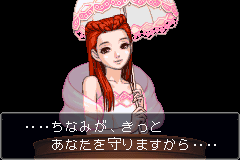
The Japanese GBA demo version contains several differences compared to the final game:
- Case 1 intro music and sound effects are different for the most part;
- The defendant lobby reuses music from the second game;
- The defense desk graphics is reused from the second game (it was given a smoother gradient in the third game);
- Mia's "hands on desk" animation has a missing part of her sleeve near her left hand, while the regular sprite has it in place. This bug was fixed in the retail game;
- Mia's "finger pointing" sprite has slight differences;
- Young Phoenix's crying animation runs at roughly double the speed;
- The demo version concludes with a unique text and Dalhia's sprite appearing on a black background;
Trivia
Here I will describe some small but interesting tidbits that do not belong elsewhere.
Since the game was ported over the second one, which in turn was ported over the first one, it also contains all its garbage graphics, like the Japanese GBA Bubbles, GBA UI Buttons, Language Buttons an so on.
